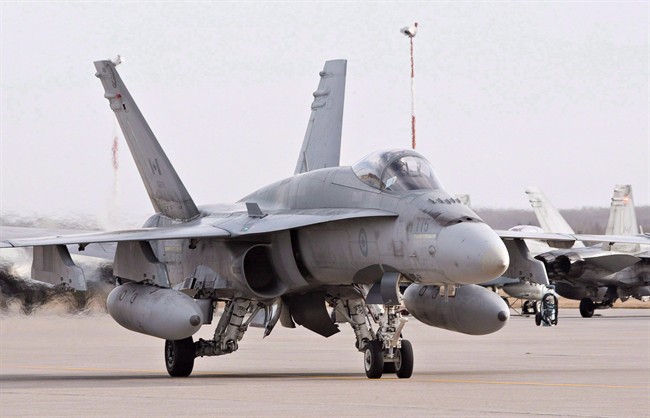A proposal to shore up Canada’s aging fleet of CF-18 fighter jets with used models from Australia could work, defence experts said Wednesday, but a better option would be to simply move ahead on permanent replacements as soon as possible.

Earlier this week, the government confirmed publicly that it is looking into buying an undisclosed number of Australian F/A-18 jets and “associated equipment” to fill what Defence Minister Harjit Sajjan has called a “capability gap” that will open as Canada’s CF-18s enter their fourth decade of service.
“Canada submitted an Expression of Interest, formally marking Canada’s interest in the Australian equipment,” read a notice posted quietly on Thanksgiving Monday.
READ MORE: Canada makes first moves toward Australian fighter jet purchase
The upside to this option, according to defence analyst David Perry, is that the Australian jets are nearly identical to Canada’s CF-18s in terms of their airframes and technical specifications.
“I think they basically have different software,” he said. “They may have a few different modifications and add-ons than we do.”
That could mean some upgrades to the jets could be needed to make sure they can fly the types of missions Canada requires, Perry added, but in general it would make it fairly easy to introduce the Australian models.
FROM THE ARCHIVES: Canada weighs the pros and cons of acquiring new fighter jets

Richard Shimooka, a senior fellow at the Macdonald-Laurier Institute’s Centre for Advancing Canada’s Interests Abroad, agreed. He called the Australian plan the “best of the options they have.”
“Canada and the Australians worked very closely on maintaining the (F/A-18) aircraft, some of them were actually refurbished in Canada … so there’s a very high familiarity among Canadian staff with those airframes,” said Shimooka, who specializes in defence procurement.
But one unknown factor is flight time. Fighter jets are rated to fly a certain number of hours by their manufacturers, Perry explained, and it’s unclear how much usable lifespan is left on the Australian models. Those lifespans can be extended, but not indefinitely.
READ MORE: Feds know how much buying fighter jets will cost, but won’t reveal the price
In terms of age, the F/A-18s from Down Under aren’t much newer than Canada’s current CF-18s, having been procured in the mid-to-late 1980s from the American company that would eventually become Boeing.
The Australian air force will be replacing them over the next several years with Lockheed Martin’s state-of-the-art F-35 jets.
According to Shimooka, Canada should be doing exactly the same — skipping over any notion of an “interim” fleet and working toward permanent replacements right now.
That presents a political dilemma, however, as the Trudeau Liberals promised during the last election campaign not to move ahead with a permanent new fleet of F-35s, while also pledging to hold an open procurement competition.
“They’re just ragging the puck, and it’s blatantly obvious,” Shimooka said.
Super Hornet remains a possibility
Barring a second-hand aircraft buy from Australia, Canada is also still mulling the purchase of over a dozen new Super Hornet jets from U.S.-based Boeing to fill the alleged capability gap.
That option remains temporarily suspended, however, as Ottawa works to resolve an ongoing trade dispute between Boeing and Canada’s own aerospace giant, Bombardier.
READ MORE: Trudeau slams Boeing for ‘trying to sue us’ and endangering Canadian jobs
Perry said the Boeing Super Hornet route remains the most problematic for a few reasons. First, there’s the reported $6.4 billion price tag on the 18 fighters, and then the subsequent requirements to train air force personnel to fly, operate and maintain the Super Hornet.
“Every aspect of doing that is time intensive,” he said. “If you buy anything that’s different, and you’re only going to fly it for 10 years, then I just have a hard time understanding how it’s a good return on investment.”
WATCH: What is going on with the Bombardier, Boeing dispute?

In a recent opinion piece published in The Globe and Mail, Shimooka and co-author David McDonough were even more direct, arguing that a Super Hornet purchase could end up being “one of the most wasteful fiascos ever undertaken by a Canadian government.”
“Having two fleets of aircraft, with the current issues that you see with manning across the armed forces, basically means that they would have to bifurcate a large amount of staff, and that means that their availability across the CF-18 fleet and across the second fleet is going to dive pretty quickly,” Shimooka said Wednesday.
“They probably wouldn’t be able to meet even one of those requirements at a time.”
The government, meanwhile, says that the Australian option is still in the very early stages and that no additional details are available about the potential deal, the flight hours logged on the used fighter jets or any future maintenance contracts.


Comments